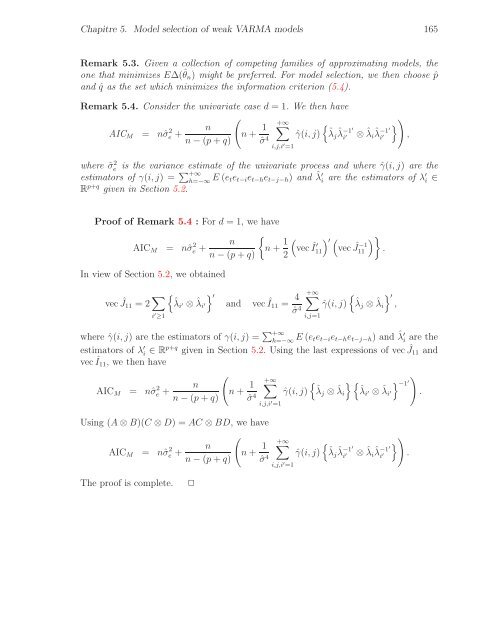THÈSE Estimation, validation et identification des modèles ARMA ...
THÈSE Estimation, validation et identification des modèles ARMA ...
THÈSE Estimation, validation et identification des modèles ARMA ...
Create successful ePaper yourself
Turn your PDF publications into a flip-book with our unique Google optimized e-Paper software.
Chapitre 5. Model selection of weak V<strong>ARMA</strong> models 165<br />
Remark 5.3. Given a collection of comp<strong>et</strong>ing families of approximating models, the<br />
one that minimizes E∆( ˆ θn) might be preferred. For model selection, we then choose ˆp<br />
and ˆq as the s<strong>et</strong> which minimizes the information criterion (5.4).<br />
Remark 5.4. Consider the univariate case d = 1. We then have<br />
AICM = nˆσ 2 <br />
n<br />
e + n+<br />
n−(p+q)<br />
1<br />
ˆσ 4<br />
+∞<br />
i,j,i ′ =1<br />
<br />
ˆγ(i,j) ˆλj ˆ λ −1′<br />
i ′ ⊗ ˆ λi ˆ λ −1′<br />
i ′<br />
<br />
,<br />
where ˆσ 2 e is the variance estimate of the univariate process and where ˆγ(i,j) are the<br />
estimators of γ(i,j) = +∞<br />
h=−∞E(<strong>et</strong><strong>et</strong>−i<strong>et</strong>−h<strong>et</strong>−j−h) and ˆ λ ′ i are the estimators of λ ′ i ∈<br />
Rp+q given in Section 5.2.<br />
Proof of Remark 5.4 : For d = 1, we have<br />
AICM = nˆσ 2 e +<br />
In view of Section 5.2, we obtained<br />
vec ˆ J11 = 2 <br />
i ′ ≥1<br />
ˆλi ′ ⊗ ˆ λi ′<br />
n<br />
n−(p+q)<br />
′<br />
<br />
n+ 1<br />
<br />
vec<br />
2<br />
Î′ ′<br />
11<br />
and vec Î11 = 4<br />
ˆσ 4<br />
+∞<br />
i,j=1<br />
vec ˆ J −1<br />
11<br />
<br />
.<br />
<br />
ˆγ(i,j) ˆλj ⊗ ˆ ′<br />
λi ,<br />
where ˆγ(i,j) are the estimators of γ(i,j) = +∞<br />
h=−∞E(<strong>et</strong><strong>et</strong>−i<strong>et</strong>−h<strong>et</strong>−j−h) and ˆ λ ′ i are the<br />
estimators of λ ′ i ∈ Rp+q given in Section 5.2. Using the last expressions of vec ˆ J11 and<br />
vecÎ11, we then have<br />
AICM = nˆσ 2 e +<br />
<br />
n<br />
n+<br />
n−(p+q)<br />
1<br />
ˆσ 4<br />
+∞<br />
i,j,i ′ =1<br />
Using (A⊗B)(C ⊗D) = AC ⊗BD, we have<br />
AICM = nˆσ 2 <br />
n<br />
e + n+<br />
n−(p+q)<br />
1<br />
ˆσ 4<br />
The proof is compl<strong>et</strong>e. ✷<br />
+∞<br />
i,j,i ′ =1<br />
<br />
ˆγ(i,j) ˆλj ⊗ ˆ <br />
λi<br />
ˆλi ′ ⊗ ˆ λi ′<br />
<br />
−1 ′<br />
.<br />
<br />
ˆγ(i,j) ˆλj ˆ λ −1′<br />
i ′ ⊗ ˆ λi ˆ λ −1′<br />
i ′<br />
<br />
.
















